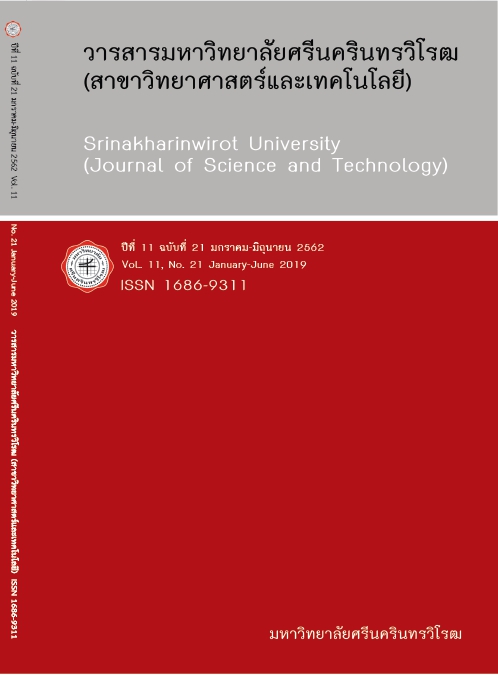ความไม่ชอบน้ำและการยับยั้งแบคทีเรียของผ้าฝ้ายเคลือบด้วยไคโตซาน ไทเทเนียมไดออกไซด์และซิลิกา HYDROPHOBICITY AND ANTIBACTERIAL ACTIVITY OF COATED COTTON FABRICS WITH CHITOSAN, TiO2 AND SiO2
Keywords:
Cotton Fabrics, Hydrophobicity, Antibacterial ActivityAbstract
Cotton fibers were coated with TiO2 doped SiO2 and chitosan to explore a method and improve hydrophobicity and antibacterial activity of the cotton fabric surface for self-cleaning. Photocatalytic TiO2 doped SiO2 and chitosan composite films were prepared by sol-gel method. Cotton fabrics were coated with chitosan (CS), TiO2 (Ti) and SiO2 (Si) by dipping. The hydrophobicity of the cotton fabrics was determined in terms of the contact angles of water droplets on the coated TiO2 composite films with UV irradiation. The antibacterial activity of the cotton surfaces was evaluated against Escherichia coli (E. coli) and Streptococcus aureus (S. aureus) according to AATCC test methods. The morphology of theTiO2 films was observed by scanning electron microscopy (SEM) and the chemical composition of the prepared films was analyzed by FTIR spectrometry. The results showed that the cotton fabric surface coating can improve hydrophobicity and antibacterial activity against E. coli and S. aureus as high as 100% even after exposure 24 hours.
Downloads
References
[2] Manoch Naksata. (2014). Waterproof Cotton Fabric Produced from Cultural Textiles with Rosin and Alum Solution. Retrieved March 8, 2018, from https://prcmu.cmu.ac.th/perin_detail.php?perin_id=600
[3] Bi, Xu. Zaisheng, Cai. Weiming, Wang. Fengyan, Ge. (2009, October). Preparation of Superhydrophobic Cotton Fabrics Based on SiO2 Nanoparticles and ZnO Nanorod Arrays with Subsequent Hydrophobic Modification. Surface & Coatings Technology. 204: 1556-1561.
[4] Esfandiar, Pakdel. Daoud A, Walid. Wang, Xungai. (2013, November). Self-Cleaning and Superhydrophilic Wool by TiO2/SiO2 Nanocomposite. Applied surface science. 275: 397-402.
[5] Bi, Xu. Jiaoe, Ding. Lei, Feng. Yinyan, Ding. Fengyan, Ge. Zaisheng, Cai. (2014, September). Self-Cleaning Cotton Fabrics via Combination of Photocatalytic TiO2 and Superhydrophobic SiO2. Surface & Coatings Technology. 262: 70-76.
[6] Jintao, Wang. Guihong, Geng. Aiqin, Wang. Xiao, Liu. Jianghua, Du. Zhongli, Zou. Shoucun, Zhang. Fenglan, Han. (2015, September). Double Biomimetic Fabrication of Robustly Superhydrophobic Cotton Fiber and Its Application in Oil Spill Cleanup. Industrial Crops and Products. 77: 36-43.
[7] Nadeeka, Tissera. Ruchira, Wijesena. Rangana, Perera. Nalinde, Silva. Gehan, Amaratunge. (2015, January). Hydrophobic Cotton Textile Surfaces Using an Amphiphilic Graphene Oxide (GO) Coating. Applied Surface Science. 324: 455-463.
[8] Yan, Zhao. Yanwei, Tang. Xungai, Wang. Tong, Lin. (2010, April). Superhydrophobic Cotton Fabric Fabricated by Electrostatic Assembly of Silica Nanoparticles and Its Remarkable Buoyancy. Applied Surface Science. 256: 6736-6742.
[9] Pisitsak, Penwisa. (2015, January-April). Introducing New Functionalities to Textiles Using the Sol-Gel Process: Water and Oil Repellent Fabrics. Thai Journal of Science and Technology. 4(1): 48-56.
[10] Rajakumar, Govindasamy. Abdul, Rahumana. Roopan, Mohana. Khanna Venkatesan, Gopiesh. Elango, Gandhi. Kamaraj, Chinnaperumal. Zahir, Abdul Abduz. Velayutham, Kanayairam. (2012, June). Fungus-Mediated Biosynthesis and Characterization of TiO2 Nanoparticles and Their Activity Against Pathogenic Bacteria. Spectrochimica Acta Part A: Molecular and Biomolecular Spectroscopy. 91: 23-29.
[11] Galkina, Olga. Sycheva, Anna. Blagodatskiy, Artem. Kaptay, George. Katanaev, Vladimir. Seisenbaeva, Gulaim. Kessler, Vadim. Agafonov, Alexander. (2014, August). The Sol-Gel Synthesis of Cotton/TiO2 Composites and Their Antibacterial Properties. Surface and Coatings Technology. 253: 171-179.
[12] Guifen, Fu. Patricia, Vary. Chhiu-Tsu, Lin. (2005, March). Anatase TiO2 Nanocomposites for Antimicrobial Coatings. The Journal of Physical Chemistry B. 109: 8889-8898.
[13] Mónica Andrea, Vargas. Jorge E., Rodríguez-Páez. (2017, January). Amorphous TiO2 Nanoparticles: Synthesis and Antibacterial Capacity. Journal of Non-Crystalline Solids. 459: 192-205.
[14] Urmas, Joost. Katre, Juganson. Meeri, Visnapuu. Monika, Mortimer. Anne, Kahru. Ergo, Nõmmiste. Urmeli, Joost. Vambola, Kisand. Angela, Ivask. (2015, December). Photocatalytic Antibacterial
Activity of Nano-TiO2 (Anatase)-Based Thin Films: Effects on Escherichia coli Cells and Fatty Acids. Journal of Photochemistry and Photobiology B: Biology. 142: 178-185.
[15] Xuhong, Jiang. Bin, Lv. Yuan, Wang. Qianhong, Shen. Xinmin, Wang. (2017, February). Bactericidal Mechanisms and Effector Targets of TiO2 and Ag-TiO2 Against Staphylococcus aureus. Journal of Medical Microbiology. 66: 440-446.
[16] Shuhui, Li. Tianxue, Zhu. Jianying, Huang. Qingqing, Guo. Guoqiang, Chen. Yuekun, Lai. (2017, March). Durable Antibacterial and UV-Protective Ag/TiO2@ Fabrics for Sustainable Biomedical Application. International Journal of Nanomedicine. 12: 2593-2606.
[17] Beihui, Tan. Bei, Gao. Jiaxing, Guo. Xiaoyan, Guo. Mingce, Long. (2013, April). A Comparison of TiO2 Coated Self-Cleaning Cotton by the Sols from Peptizing and Hydrothermal Routes. Surface & Coatings Technology. 232: 26-32.
[18] Yunhui, Xu. Chen, Qiu. Xiaoli, Zhang. Weiwei, Zhang. (2014, November). Crosslinking Chitosan into H3PO4/HNO3–NANO2 Oxidized Cellulose Fabrics as Antibacterial-Finished Material. Carbohydrate Polymers. 112: 186-194.
[19] Ruhi, Gazala. Modi Om, Prakash. and Dhawan Sundeep, Kumar. (2014, December). Chitosan-Polypyrrole-SiO2 Composite Coatings with Advanced Anticorrosive Properties. Synthetic Metals. 200: 1-16.
[20] Tiezheng, Tong. Shereef, Anas. Jinsong, Wu. Thi Thanh Binh, Chu. Kelly, John. J. Gaillard, Jean-François. Gray, Kimberly A. (2013, October). Effects of Material Morphology on the Phototoxicity of Nano-TiO2 to Bacteria. Environmental science & technology. 47: 12486-12495.
[21] Funda, Sayilkan. Fatma, Bilge Emre. (2016, April). Characterization and Photocatalytic Properties of TiO2/Chitosan Nanocomposites Synthesized by Hydrothermal Process. Turkish Journal of Chemistry. 40: 28-37.
[22] Kandiah, Kavitha. Muthusamy, Prabhu. Venkatachalam, Rajendran. Manivasankana, Palanisamy. Prabu, Periasamy. (2013, May). Optimization of Nano-Titania and Titania-Chitosan Nanocomposite to Enhance Biocompatibility. Current Nanoscience. 9: 308-317.
[23] Khan, Tanveer Ahmad. Peh, Kok Khiang. Ch’ng, Hung Seng. (2002, August). Reporting Degree of Deacetylation Values of Chitosan: the Influence of Analytical Methods. Journal of Pharmacy & Pharmaceutical Sciences. 5(3): 205-212.
[24] Philippova, Olga. and Korchagina, Evgeniya. (2012, July). Chitosan and its Hydrophobic Derivatives: Preparation and Aggregation in Dilute Aqueous Solutions. Polymer Science Series A. 54(7): 552-572.
[25] Chao-Hua, Xue. Shun-Tian, Jia. Hong-Zheng, Chen. Mang, Wang. (2008, July). Superhydrophobic Cotton Fabrics Prepared by Sol-Gel Coating of TiO2 and Surface Hydrophobization. Science and Technology of Advanced Materials. 9(3): 1-5.
[26] Mohamed, Gobara. (2015, February). Effects of TiO2/SiO2 Reinforced Nanoparticles on the Mmechanical Properties of Green Hybrid Coating. International Letters of Chemistry, Physics and Astronomy. 47: 56-66.
Downloads
Published
How to Cite
Issue
Section
License
Srinakharinwirot University Journal of Sciences and Technology is licensed Under a Creative Commons Attribution-NonCommercial-NoDerivs 4.0 International (CC-BY-NC-ND 4.0) License, Unless Otherwise Stated. Please Read Journal Policies Page for More Information on Open Access, Copyright and Permissions.



